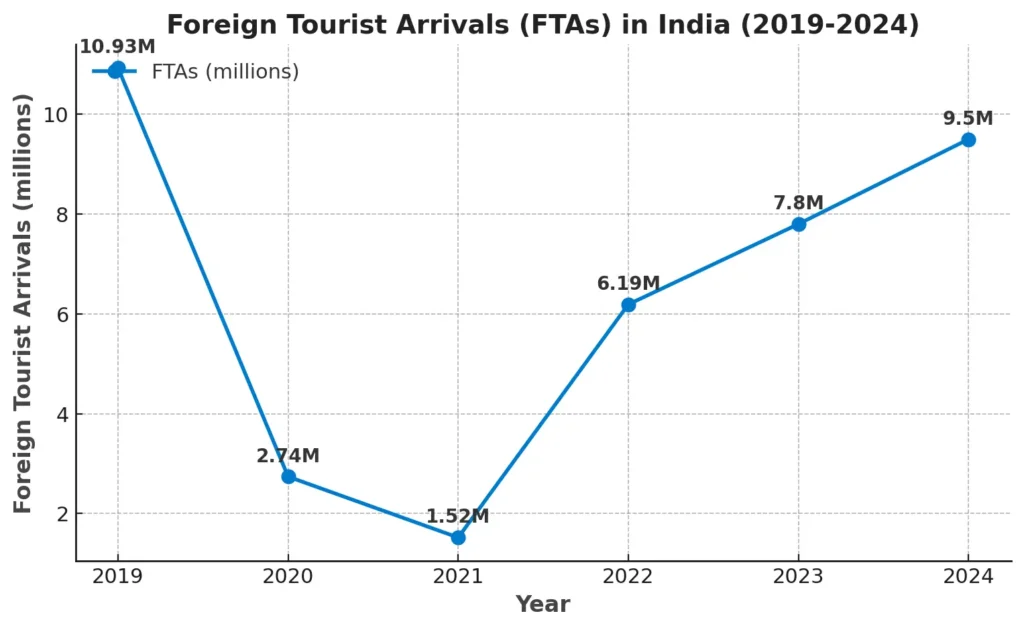Introduction
India’s tourism industry has consistently remained in the global spotlight, largely due to the influx of visitors during major cultural, sporting, and religious events such as the Kumbh Mela, international cricket tournaments, and large-scale music concerts. These events generate significant economic activity and temporarily drive up local tourism revenues. However, despite these short-term gains, key tourism indicators such as foreign tourist arrivals (FTAs), revenue per available room (RevPAR), and the performance of tourism-related stocks have exhibited a sluggish growth pattern. This paradox raises critical concerns about the sustainability of India’s tourism sector beyond event-driven peaks and emphasizes the need for structural improvements to maintain long-term momentum.
Event-Driven Tourism: A Short-Term Boost
Large-scale events, including the Kumbh Mela, the ICC Cricket World Cup, and prominent music festivals, have historically provided momentary spikes in tourism demand. For instance, the 2019 Kumbh Mela attracted millions of pilgrims, significantly bolstering the local economy. Similarly, major cricket events such as the World Cup lead to a surge in hotel occupancy rates and airline bookings. However, the long-term sustainability of this demand remains uncertain, as India’s tourism-related stocks have consistently underperformed, as reported by LiveMint (2023). These events, while beneficial in the short term, do not contribute to sustained tourism growth due to their episodic nature.
Declining Key Tourism Indices: The Economic Perspective
Despite the temporary influx of visitors during major events, broader tourism performance indicators present a less optimistic picture. According to the Ministry of Tourism’s Annual Report 2023-24, India received 6.19 million FTAs in 2022, a significant increase from 1.52 million in 2021. However, this figure still lags behind the pre-pandemic levels of 10.93 million recorded in 2019. Preliminary 2023 estimates by the Federation of Associations in Indian Tourism & Hospitality (FAITH) suggest that FTAs rose to approximately 7.8 million, showing some recovery but still falling short of pre-pandemic levels. Factors such as visa restrictions, rising airfare costs, and a sluggish global economy have hampered a full recovery. Projections from ICRA Ratings for 2024 estimate FTAs to reach around 9.5 million, supported by government initiatives such as the Dekho Apna Desh campaign and relaxed e-visa regulations.

Data Source: Ministry of Tourism (Govt. of India), FAITH 2023 Estimates, ICRA 2024 Projections.
The FTA graph visually represents India’s foreign tourist arrival trends from 2019 to 2024, highlighting the sharp decline during the pandemic and the slow recovery in the following years. The data illustrates how, despite high-profile events boosting short-term tourism, overall FTAs have struggled to return to pre-pandemic levels. While 2023 showed improvement with an estimated 7.8 million FTAs, the figures remain lower than the 2019 peak of 10.93 million. Projections for 2024 suggest a continued recovery, reaching approximately 9.5 million FTAs, driven by policy initiatives and eased travel restrictions.
Despite the demand generated by marquee events, the financial performance of tourism stocks remains underwhelming. As highlighted by LiveMint (2023), investors are wary of relying on event-driven surges as a long-term growth strategy. In 2023, RevPAR experienced an estimated 6.5% increase, fueled by major events such as the ICC World Cup and the G20 Summit in New Delhi, according to Hotelivate (2023). The outlook for 2024 suggests an additional RevPAR growth of 5-7%, primarily due to international collaborations in the hospitality sector and a greater emphasis on luxury tourism. However, a significant portion of visitors consists of budget-conscious travelers who opt for short stays, leading to lower revenue per tourist compared to long-haul vacationers.
India also faces significant seasonality concerns and an overreliance on specific tourism segments. Unlike Thailand and Dubai, which attract tourists year-round, India’s tourism landscape is heavily dependent on religious and event-based travel. Data from the Indian Association of Tour Operators (IATO) in 2023 revealed that approximately 85% of inbound tourists visited India for leisure and cultural events, while segments such as business and luxury travel remain underdeveloped. To address these challenges, NITI Aayog has introduced initiatives in 2024 aimed at reducing seasonal fluctuations through incentives for off-season travel and eco-tourism projects.
Structural Issues Hindering Sustainable Growth
While India’s diverse tourism landscape offers immense potential, several macroeconomic and policy-related obstacles hinder sustained growth. High taxation and travel costs make India less competitive compared to destinations in Southeast Asia. Economic Times (2023) reports that GST rates on luxury hotels reach up to 28%, making India a less attractive destination for high-end travelers. Additionally, expensive domestic airfares further discourage intra-country travel, limiting the potential for domestic tourism growth. However, the 2024 budget proposals indicate possible tax revisions aimed at making inbound tourism more competitive, according to Business Standard (2024).
Infrastructure gaps and last-mile connectivity issues also present significant challenges. While India has made substantial investments in airport expansions, the lack of well-integrated railway and road networks continues to hinder accessibility to key tourist destinations. Rural and eco-tourism sites are particularly affected by inadequate transport and accommodation facilities. In response, NITI Aayog has outlined infrastructure development plans for 2024, which include high-speed rail projects and regional airport expansions to improve connectivity.
India’s over-reliance on budget and religious tourism further limits revenue growth potential. While events such as the Kumbh Mela attract mass tourism, they primarily cater to low-budget travelers, thereby capping high-end tourism earnings. Unlike Dubai, which has successfully positioned itself as a global luxury and MICE (Meetings, Incentives, Conferences, and Exhibitions) hub, India still struggles with the necessary infrastructure to attract premium tourists. However, the expansion of luxury hospitality chains such as Taj and Oberoi in 2024 signals a strategic shift toward high-end tourism, as reported by Hotelivate (2024).
The Way Forward: Strategies for Sustainable Tourism Growth
To ensure long-term tourism growth beyond event-driven spikes, India must adopt a multi-faceted strategy. Diversification beyond religious and event-based tourism is crucial, with a strong emphasis on medical tourism. India already holds a competitive edge in affordable healthcare services, and promoting wellness tourism through Ayurvedic and holistic healing experiences could significantly enhance its attractiveness. The Ministry of AYUSH has launched new campaigns in 2024 to further develop wellness tourism as a key segment.
Addressing the issue of high GST rates and travel costs is another critical area for improvement. Revising hotel GST rates to align with global standards could enhance India’s competitiveness in attracting international tourists. Economic Times (2024) reports that new policy recommendations advocate for reduced service taxes on international bookings, which could positively impact inbound tourism. Additionally, offering subsidies on domestic air travel during off-peak seasons could boost intra-India travel and mitigate seasonal dips in tourist arrivals.
Investment in year-round tourism infrastructure remains imperative. Enhancing public transport networks, upgrading highways, and ensuring seamless last-mile connectivity can significantly improve the overall travel experience. Encouraging private-sector investments in luxury accommodations and entertainment hubs is also essential. According to Hotelivate (2024), private sector commitments in 2024 have surpassed $3 billion in hospitality and infrastructure, reflecting growing confidence in the industry’s long-term potential.
Conclusion
While mega-events provide short-term boosts to India’s tourism sector, achieving long-term growth requires fundamental policy reforms and strategic diversification. Addressing infrastructure deficits, taxation issues, and seasonality concerns will be crucial in transforming India into a globally competitive tourism destination. Collaboration between the government and private sector will play a pivotal role in building a robust, year-round tourism ecosystem. With 2024 shaping up to be a transformative year for policy shifts, India’s ability to implement these changes effectively will determine the future trajectory of its tourism industry.

